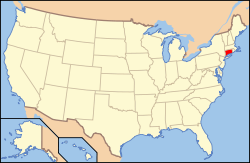Connecticut (wine)
| Wine region | |
 |
|
| Official name | State of Connecticut |
|---|---|
| Type | U.S. state |
| Year established | 1788 |
| Country | United States |
| Sub-regions | Southeastern New England AVA, Western Connecticut Highlands AVA |
| Total area | 5,543 square miles (14,356 km2) |
| Grapes produced | Aurore, Cabernet Franc, Cabernet Sauvignon, Cayuga, Chambourcin, Chardonel, Chardonnay, Frontenac, Gewurztraminer, Marechal Foch, Merlot, Pinot gris, Riesling, Seyval blanc, St. Croix, Vidal blanc, Vignoles |
| No. of wineries | 18 |
Connecticut wine refers to wine made from grapes and other fruit grown in the U.S. state of Connecticut. The modern wine industry in Connecticut began with the passage of the Connecticut Winery Act in 1978. The wineries in Connecticut are located throughout the state, including in the two designated American Viticultural Areas in the state. The climate in the coastal region near Long Island Sound and the Connecticut River valley tends to be warmer than the highlands in the eastern and western sides of the state.
The Connecticut Wine Trail is route linking approved wineries located in the state of Connecticut. As of 2015, there are 33 wineries on the trail. Members of the CT Wine Trail participate with other Connecticut farm wineries in the Passport to Connecticut Farm Wineries sponsored by the Connecticut Farm Wine Development Council and the Connecticut Department of Agriculture.
Sherman P. Haight Jr. of Haight Vineyard in Litchfield conceived of the idea of the wine trail in 1988. It was officially dedicated by the state in 1992 with five wineries. The trail has grown over time to its current roster of 23 wineries as of 2011.
Wineries such as Bishop's Orchards are found on the Connecticut Wine Trail.
...
Wikipedia
